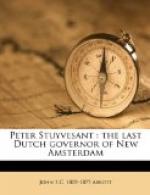The colony soon numbered about two hundred persons. The village consisted of thirty log houses, extending along the banks of the East River. These cabins were one story high, with thatched roof, wooden chimneys, and two rooms on the floor. Barrels, placed on an end, furnished the tables. The chairs were logs of wood. Undoubtedly in many of these humble homes more true happiness was found than is now experienced in some of the palatial mansions which grace the gorgeous avenues of the city. About this time three ships arrived, containing a large number of families with farming implements, and over a hundred head of cattle. To prevent the cattle from being lost in the woods, they were pastured on Governor’s, then called Nutten’s Island.
And now the tide of emigration began pretty rapidly to increase. The Dutch transported emigrants for twelve and a half cents a day, during the voyage, for both passage and food. They also gave them, upon reaching the colony, as much land as they were able to cultivate. With a wise toleration, which greatly honored them, the fullest religious freedom of speech and worship was allowed.
A strong block-house, surrounded with palisades of red cedar, was thrown up on the south point of Manhattan Island, and was called Fort Amsterdam. This became the headquarters of the government and the capital of the extended, though not very clearly defined, realm of New Netherland.
An unfortunate occurrence now took place which eventually involved the colony in serious trouble. An Indian, from the vicinity of Westchester, came with his nephew, a small boy, bringing some beaver skins to barter with the Dutch at the fort. The narrow trail through the forest, led in a southeast direction, along the shore of the East River, till it reached what was called Kip’s Bay. Then, diverging to the west, it passed near the pond of fresh water, which was about half way between what are now Broadway and Chatham streets. This pond, for a century or more, was known as the Kolck or the Collect.
When the Indians reached this point, they were waylaid by three white men, robbed of their furs, and the elder one was murdered. The boy made his escape and returned to his wilderness home, vowing to revenge the murder of his uncle. It does not appear that the Dutch authorities were informed of this murder. They certainly did not punish the murderers, nor make any attempt to expiate the crime, by presents to the Indians.
“The island of Manhattan,” wrote De Rassieres at this time,
“is full of trees and in the middle rocky. On the north side there is good land in two places, where two farmers, each with four horses, would have enough to do without much grubbing or clearing at first. The grass is good in the forests and valleys; but when made into hay, it is not so nutritious for the cattle as the hay in Holland, in consequence of its wild state, yet it annually improves by culture.




